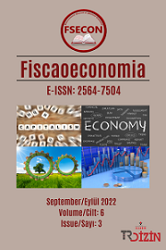Türkiye’de Karbon Histeri Hipotezi Geçerli midir?: Fourier Birim Kök Testlerinden Kanıtlar
Carbon Hysteresis Hypothesis is Valid in Turkey?: Evidence from Fourier Unit Root Tests
Author(s): Abdullah Emre Çağlar, Mehmet MertSubject(s): Energy and Environmental Studies, Environmental and Energy policy, International relations/trade, Environmental interactions, Globalization
Published by: Ahmet Arif Eren
Keywords: Carbon hysteresis hypothesis; Positive hysteresis; Negative hysteresis; Fourier ADF unit root; Fourier LM unit root;
Summary/Abstract: The aim of this study is to investigate whether the carbon hysteresis hypothesis is valid in Turkey. With this study, it is aimed to improve the environmental quality in Turkey, which is one of the most emitter countries. For the presence of carbon hysteresis, the unit root properties of the CO2 emissions series are primarily investigated by Fourier-based ADF and LM tests. The results from Fourier-based tests show that the trigonometric terms are insignificant in the model. Thus, ordinary ADF unit root test results are reliable for CO2 emissions. However, Fourier ADF and LM tests require frequency numbers to be integers. In order to increase the reliability of the results, the stability of the CO2 emissions series is examined with the FFFFFADF test, which allows for fractional frequency and was developed by Omay (2015). The results of the FFFFF-ADF unit root test indicate that the series of emissions has a unit root and this result provides evidence that the carbon hysteresis hypothesis is valid in Turkey. Then, using the sequential Bai-Perron approach for the determination of the direction of the hysteresis, the sample period has been divided into regimes and it has been seen that the positive carbon hysteresis has been valid in all regimes. In conclusion, this study presents important environmental policies for Turkey’s carbon reduction targets.
Journal: Fiscaoeconomia
- Issue Year: 6/2022
- Issue No: 3
- Page Range: 1587-1610
- Page Count: 24
- Language: Turkish

